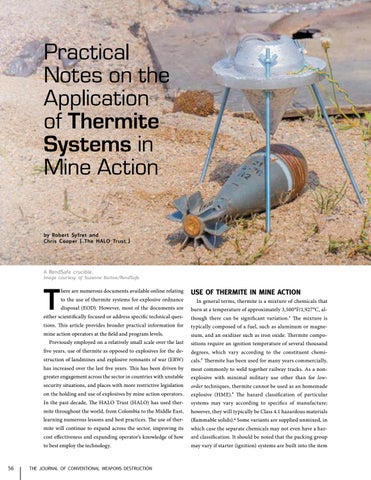Practical Notes on the Application of Thermite Systems in Mine Action by Robert Syfret and Chris Cooper [ The HALO Trust ]
A RendSafe crucible.
Image courtesy of Suzanne Barlow/RendSafe.
T
here are numerous documents available online relating to the use of thermite systems for explosive ordnance disposal (EOD). However, most of the documents are
either scientifically focused or address specific technical questions. This article provides broader practical information for mine action operators at the field and program levels. Previously employed on a relatively small scale over the last five years, use of thermite as opposed to explosives for the de-
56
USE OF THERMITE IN MINE ACTION In general terms, thermite is a mixture of chemicals that burn at a temperature of approximately 3,500°F/1,927°C, although there can be significant variation.1 The mixture is typically composed of a fuel, such as aluminum or magnesium, and an oxidizer such as iron oxide. Thermite compositions require an ignition temperature of several thousand degrees, which vary according to the constituent chemi-
struction of landmines and explosive remnants of war (ERW)
cals.2 Thermite has been used for many years commercially,
has increased over the last five years. This has been driven by
most commonly to weld together railway tracks. As a non-
greater engagement across the sector in countries with unstable
explosive with minimal military use other than for low-
security situations, and places with more restrictive legislation
order techniques, thermite cannot be used as an homemade
on the holding and use of explosives by mine action operators.
explosive (HME).3 The hazard classification of particular
In the past decade, The HALO Trust (HALO) has used ther-
systems may vary according to specifics of manufacture;
mite throughout the world, from Colombia to the Middle East,
however, they will typically be Class 4.1 hazardous materials
learning numerous lessons and best practices. The use of ther-
(flammable solids).4 Some variants are supplied unmixed, in
mite will continue to expand across the sector, improving its
which case the separate chemicals may not even have a haz-
cost effectiveness and expanding operator’s knowledge of how
ard classification. It should be noted that the packing group
to best employ the technology.
may vary if starter (ignition) systems are built into the item
THE JOURNAL OF CONVENTIONAL WEAPONS DESTRUCTION









